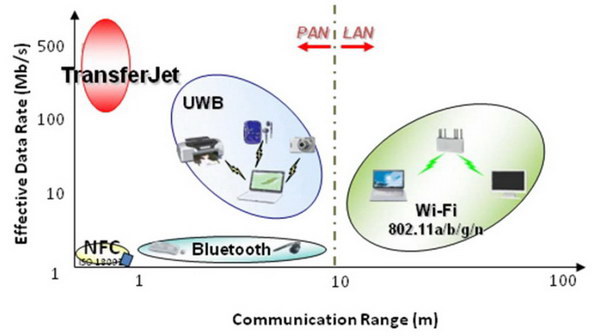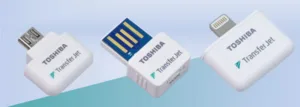On March 1st, Toshiba announced a TransferJet adapter for the Apple iPhone, iPad and iPod. According to Toshiba, this is the first Apple-compatible TransferJet adaptor available on the market. Simultaneously, the company launched similar adaptors for Android and desktop PCs. The Android and PC adaptors are 30% smaller, have 30% lower power consumption and 1.7x the data transfer rate of previous TransferJet adaptors from Toshiba for these platforms. Basic properties of the three new adaptors are shown in the table. All three adaptors are currently available in Japan and have an Open Price, meaning there is no manufacturer’s suggested price.
TransferJet Adapters available from Toshiba with (left to right) MicroUSB, USB and Lightning connectors (Source: Toshiba)
| Apple iOS | Android | Desktop | |
| Part Number | TJ-LT00A | TJ-MU00B | TJ-UA00B |
| Connector | Lightning | MicroUSB | USB |
| Interface | Lightning (iAP2) | USB 2.0 | USB 2.0 |
| OS | iOS 7.1 and 8.1 | Android 4.0 – 4.4 | Windows 7, 8 (both 32 and 64 bit versions) |
| Source: Toshiba, Compiled by Meko | |||
TransferJet is a protocol established by the TransferJet Consortium which exhibited at the Mobile World Congress, March 2 – 5 in Barcelona, Spain. TransferJet was originally developed in 2008 by Sony Corporation, which retains the trademark but licenses it to members of the consortium. Besides Sony and Toshiba, the consortium has over 50 members, including Hitachi Ltd, JVC-Kenwood, Nikon, Olympus, Panasonic, Pioneer and Seiko Epson. The first commercial products were launched in 2010.
TransferJet is similar to NFC in that it has extremely short range and is intended for device to device transfer of files. The short range provides data security and makes it difficult or impossible for the transmission to be intercepted.
The big difference between TransferJet and NFC is TransferJet has a much higher bit rate. While NFC is primarily intended for financial transactions, TransferJet can rapidly transfer large data files. For example, according to Toshiba, you can transfer 1 minute of high-definition video content in about 3 seconds using their new TransferJet adaptors. This puts it more in competition with UWB than with NFC technology. UWB, which operates in the 60GHz band, has a comparable data transfer rate but a much longer range and is intended to provide wireless connectivity between things like laptop computers and back-up disk drives.
TransferJet operates on a center frequency of 4.48 GHz and uses an electric induction field coupler antenna element. The design of this antenna limits range to a few centimeters. The data transmission rate is a maximum of 560 Mbps with an effective throughput of 375 Mbps. TransferJet complies with the RF regulations of South Korea, Japan, the US and the EU.

Positioning of TransferJet Technology (Source: TransferJet Consortium)
TransferJet has two main modes, according to the consortium. These are:
- File transfer, Push: a file on a mobile device is pushed onto another mobile device such as a tablet or a host such as a laptop.
- File transfer, Pull: a file is pulled from a source onto a mobile device.
These modes enable a variety of applications such as real time media transfer and transfer data into and out of kiosks. One kiosk example given by the consortium is a photo printing booth. Wirelessly transfer your photo into one of these kiosks and get a near-instant print for sharing.
Analyst Comment
As I mentioned in my report from MWC, I see TransferJet struggling for acceptance as Wi-Fi 802.11ad has similar functionality. At MWC, staff told us that the TransferJet protocol was quicker to negotiate, but I think this is a marginal advantage given the likely ubiquity of the Wi-Fi standard in the future. Of course, if 802.11ad hits a roadblock, things might change. The kiosk application that I thought was interesting was in very fast transfer of movies to a tablet or phablet in a couple of minutes before a flight or other journey. (BR)

